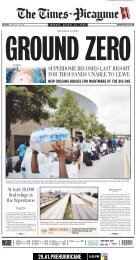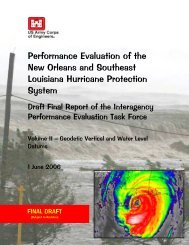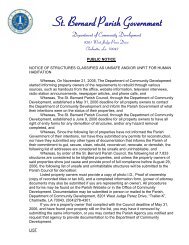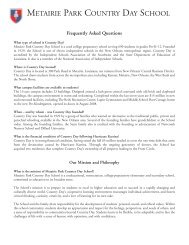IPET Report 3 Vol VIII
IPET Report 3 Vol VIII
IPET Report 3 Vol VIII
Create successful ePaper yourself
Turn your PDF publications into a flip-book with our unique Google optimized e-Paper software.
components were developed based on design and construction information, and on the results of<br />
the Performance Team and the Pump Stations Team studies. Reliability models were developed<br />
and evaluated to determine dominant, or most likely, failure modes for each reach defined in a<br />
drainage basin.<br />
The reliability models included uncertainties in structural material properties, geotechnical<br />
engineering properties, subsurface soil profile conditions, and engineering performance models<br />
of levees, floodwalls, and transition points. Uncertainties due to spatial and temporal variation,<br />
and due to limited knowledge are tracked separately in the analysis, providing a best estimate of<br />
the frequency of failure under given loads, along with a measure of the uncertainty in that<br />
frequency.<br />
The HPS was comprised of levees, flood walls, levees with floodwalls on top, and various<br />
points of transition or localized facilities such as pumping stations, drainage works, pipes<br />
penetrating the HPS, and gates. Each drainage basin perimeter was divided into segments,<br />
referred to as reaches, which were deemed to be homogeneous in three respects: structural crosssection,<br />
elevations in the cross section, and geotechnical cross-section. For example, 30 such<br />
reaches were identified for the New Orleans East (NOE) drainage basin.<br />
Geometric and engineering material properties were identified for each reach and summarized<br />
in data tables. Structural cross-sections were initially identified by review of as-built<br />
drawings, aerial photographs, and GIS overlays; and were subsequently confirmed in on-site<br />
reconnaissance. Elevations were assessed in the same reconnaissance, supplemented by LIDAR<br />
and field surveys provided to the Risk Team. Geotechnical cross-sections and corresponding soil<br />
engineering properties were derived from original USACE General Design Memoranda (GDM)<br />
for the respective project areas of each drainage basin, supplemented by site characterization<br />
data collected post-Katrina at levee and flood wall failure sites (cone penetrometer and<br />
laboratory measurements on undisturbed samples).<br />
Engineering performance models and calculations were adapted from the GDM’s. Engineering<br />
parameter and model uncertainties were propagated through those calculations to obtain<br />
approximate fragility curves as a function of water height for components of the HPS. These<br />
results were calibrated against the analyses of the Performance Team, which applied more<br />
sophisticated analysis techniques to similar structural and geotechnical profiles in the vicinity of<br />
failures. Failure modes identified by the Performance Team were incorporated into the reliability<br />
analyses as those results became available.<br />
Reliability assessments were performed for individual reaches of the HPS for given water<br />
elevations. This resulted in fragility curves for each reach by mode of failure. A fragility curve<br />
gives the probability of failure, conditional upon an event (water elevation in this study), at<br />
which a limiting failure state is exceeded.<br />
Reliability assessments for each reach and component of the drainage basin perimeter were<br />
combined in the HPS risk model. The risk model used the water elevations from the hurricane<br />
hazard and the HPS fragilities to calculate probability of volume and duration of flooding within<br />
each drainage basin. The system risk model is structured around an event-tree description of the<br />
occurrence of hurricane events, corresponding water and wave heights, and the resulting<br />
<strong>Vol</strong>ume <strong>VIII</strong> Engineering and Operational Risk and Reliability Analysis <strong>VIII</strong>-43<br />
This is a preliminary report subject to revision; it does not contain final conclusions of the United States Army Corps of Engineers.













